I'm in the middle of translating a collection of recipes all based on locally available ingredients of Cretan origin, presented in new combinations. The recipes have all been devised by the head chef at MAICh, John Apostolakis. John's cooking style differs from the normal local cuisine in that he uses the same ingredients as one would expect in Cretan cooking, with a special emphasis on locally available ingredients, but the combinations would be considered unusual while the recipes are unique.
John Apostolakis, busy in the MAICh kitchen
John and his team cook and prepare food daily for 250 people, breakfast, lunch and dinner. His meals always contain a wide variety of fresh produce for all meals. There is always a Cretan emphasis in his creations, even though the food he presents isn't what you would expect to see being prepared in the average Cretan home. His philosophy is based on what he believes is a healthy meal served at the appropriate moment. His recipes all include locally available products (including newer cultivations like the recently introduced avocado) and locally made products (especially in his use of local cheese varieties). They do not use any refined cooking knowledge or processes, and neither does Cretan cooking; the best Cretan meals rely on the freshest highest-quality ingredients available to produce superlative their taste. Nor do they rely on exact measurements: the amount of each ingredient depends on preference and subtle taste combinations, all of which depend on the cook's/eater's mood.
The students at MAICh eat their three full meals a day in the student restaurant. They start off with breakfast, which always looks like a tempting buffet smorgasbord. Apart from the common continental breakfast of bread and jam, or milk and cereals, the counter is also decorated with fresh seasonal salad (at the moment, you can choose between avocado, tomato, cucumber and olives), the same applying for fruit (right now, the grape season is in full swing). Lunch always consists of an array of salads - one of beans, one of potatoes, a green one, a red one, and a mixed one - to accompany a light, hot meal: spaghetti with a variety of sauces, vegetarian pizza, stewed or stuffed vegetables, to name a few. Dinner always consists of a stewed or roast meat dish, accompanied again by a range of salads.
When I sit at a seaside taverna only a few minutes away from my house, where he rich and the poor are sitting on neighbouring tables eating the same kind of food from the limited menu of the eaterie, I can truly feel that democracy really was born in Greece.
The staff also join the students at lunch in true Greek democratic style. These meal times are often my favorite in the week, because I do not have to cook or clean up afterwards, and there is always such a good variety of 'creative' food available that I find it difficult to eat 'sensibly'.
*** *** ***
I use an online translator tool for all translation work. Most people will complain that translator tools generate crazy translations; that is such an unfair comment. Translation tools take the time-consuming mundane manual writing/typing work out of the translation task, freeing up a translator's time and making the translation quicker and easier (and therefore cheaper) to produce. True, a translation tool will not be produce a translated piece of literature (as in a novel), but it is a useful tool for more neutral texts where most words are used in their literal meanings.Believe it or not, translating a cookbook from Greek to English is harder than translating a scientific text from English to Greek. Scientific texts use the literal, often a very specific, meaning of a word, which usually have an exact (or near-exact) one-word meaning in another language. This is not the case in cooking. Recipes from highly culturally based and/or localised cuisines often use obscure terms for ingredients which rarely have a direct translation in another language, although there may be some other more well-known word that roughly describes the ingredient.
A good example of this is how to translate 'mizithra', a white soft full-fat curd cheese produced all over Crete. To complicate matters, the term 'mizithra' is used all over Greece to denote different kinds of cheeses, according to the locality! As if that is not enough, the term 'mizithra' in Hania is used to denote a different cheese from the one the same word denotes in Iraklio, a prefecture of Eastern Crete, only 150 kilometres away!! The icing on the cake is that the term 'mizithra' is also PDO (Protected Designation of Origin) in Greece, denoting the white soft curd cheese produced in Hania (ie Western Crete, as opposed to Eastern Crete)!!!
Mizithra (PDO) in Hania shares some similarities with the well-known Italian ricotta cheese. Translating 'mizithra' as 'ricotta' makes Cretan cuisine sound like an imitation of Italian cuisine, in turn globalising the term. The other side of the coin is that anyone in the world should be able to use a translated cookbook (otherwise, why bother to translate it); if the exact ingredients cannot be found in a certain place, an alternative similar ingredient should be readily available. Cretan mizithra could be 'paneer' in India, 'ricotta' in Italy, 'cottage cheese' in Britain - but what about Thailand, where cheese is not eaten at all among the locals? Does 'tofu' fit the bill here? (The answer to that one is a firm 'No.')
*** *** ***
Here is a sample translation of one of John's recipes:
Σαλάτα με χούμελι και νιφάδες παλαιωμένης γραβιέρας
1 μαρούλι
250 γρ. σταμναγκάθι
2 κ.σ. χούμελι
3-4 κ.σ. έξτρα παρθένο ελαιόλαδο
50-60 γρ. γραβιέρα
ανθό του αλατιού
Πλένουμε το μαρούλι και το σταμναγκάθι, τα αφήνουμε λίγο να στεγνώσουν, τα κόβουμε, προσθέτουμε τη χούμελι και το έξτρα παρθένο ελαιόλαδο, κόβουμε τη γραβιέρα νιφάδες και τη προσθέτουμε στη σαλάτα μας.
1 μαρούλι
250 γρ. σταμναγκάθι
2 κ.σ. χούμελι
3-4 κ.σ. έξτρα παρθένο ελαιόλαδο
50-60 γρ. γραβιέρα
ανθό του αλατιού
Πλένουμε το μαρούλι και το σταμναγκάθι, τα αφήνουμε λίγο να στεγνώσουν, τα κόβουμε, προσθέτουμε τη χούμελι και το έξτρα παρθένο ελαιόλαδο, κόβουμε τη γραβιέρα νιφάδες και τη προσθέτουμε στη σαλάτα μας.
Using an online translator tool, you get something like this:
Salad and chips choumeli outdated graviera
1 cos
250 gr. stamnagathi
2 tablespoons choumeli
3.4 tbsp extra virgin olive oil
50-60 gr. gruyere
flower of salt
Wash the lettuce and stamnagathi, just let them dry, we cut them, add the choumeli and extra virgin olive oil, cut the ginger, flakes and add to our salad.
No doubt, there are a number of words the average reader will not be familiar with:
1 cos
250 gr. stamnagathi
2 tablespoons choumeli
3.4 tbsp extra virgin olive oil
50-60 gr. gruyere
flower of salt
Wash the lettuce and stamnagathi, just let them dry, we cut them, add the choumeli and extra virgin olive oil, cut the ginger, flakes and add to our salad.
No doubt, there are a number of words the average reader will not be familiar with:
- choumeli: this food product is not widespread and very little is known about it. It needs a clear definition. As it is a highly localised food product, a suitable alternative must be suggested to the reader (which, in this case, is honey - use a lesser amount than stated);
- graviera: it comes from the same word as 'gruyere', and denotes a similar kind of cheese. For some reason, the translator tool translates 'graviera' as 'gruyere', but simply transliterates the Greek letters into English in another occurrence in the same recipe, while the third occurrence of the same word is translated as 'ginger'!
- cos: the translator tool automatically chose the cos variety for the translation of the Greek word for 'lettuce' - for those not familiar with cos lettuce, this needs to be explained. In any case, other lettuce varieties can also be used instead of cos;
- stamnagathi: this refers to a local variety of a specific species of a wild (nowadays cultivated) green that grows only in Crete. It is relatively well known among the Greek culinary world, although it is difficult to designate a reasonable alternative. It is often referred to as 'spiny chicory' in English, due to its scientific name: Chicorium spinosum*.
Lettuce and stamnagathi salad with choumeli and aged graviera flakes
1 lettuce (the Cos variety is widely used in Greece)
250g stamnagathi (spiny chicory, a wild green cultivated in Crete)
2 tbsp choumeli (a honey product, made by boiling the honeycomb)
3-4 tbsp extra virgin olive oil
50-60g Cretan graviera (hard yellow cheese similar to Swiss gruyere)
fleur de sel

Wash the lettuce and stamnagathi, allow to dry, and tear the leaves. Add the choumeli and extra virgin olive oil, slice the cheese into thin flaky shavings, and add to the salad.
1 lettuce (the Cos variety is widely used in Greece)
250g stamnagathi (spiny chicory, a wild green cultivated in Crete)
2 tbsp choumeli (a honey product, made by boiling the honeycomb)
3-4 tbsp extra virgin olive oil
50-60g Cretan graviera (hard yellow cheese similar to Swiss gruyere)
fleur de sel

Wash the lettuce and stamnagathi, allow to dry, and tear the leaves. Add the choumeli and extra virgin olive oil, slice the cheese into thin flaky shavings, and add to the salad.
This salad differs from local cuisine in that it has a sweet dressing (not the norm for Cretan cuisine to pair sweet with savoury) and the stamnagathi is served raw (stamnagathi is usually boiled). It also uses only a small amount of olive oil, another element in John's cooking style. He insists on using only extra virgin olive oil, but in very small quantities. This is a good thing because Cretans use too much of it in too much of their food, which does not bode well for their health (it has too many calories). Whereas only 40-50 years ago the average Cretan farmer walked 15 kilometres a day in and around his neighbourhood and fields, the modern Cretan farmer drives this number of kilometres instead and only walks two. Quantity of food needs to be balanced with the current dietary needs of a relatively sedentary lifestyle, while whatever quantity is lost should be replaced with quality.
And what shall we pair this salad with? How about some kolokithoanthous?
Κολοκυθοανθοί γεμιστοί με ανθότυρο
20 τεμ. κολοκυθοανθοί
150 γρ. ανθότυρο
λίγο δυόσμο, ματζουράνα
ανθό του αλατιού
1 κ.σ. έξτρα παρθένο ελαιόλαδο
250 γρ. αλεύρι
200 γρ. νερό
λίγο ανθό του αλατιού
1 κ.γ. τσικουδιά
έξτρα παρθένο ελαιόλαδο για το τηγάνισμα
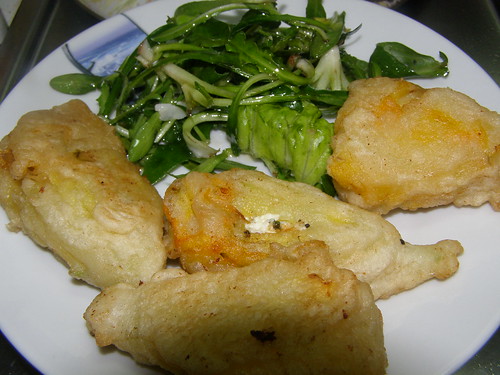
Πλένουμε προσεχτικά τους ανθούς για να μη σπάσουν, αναμιγνύομε τον ανθότυρο με το δυόσμο και τη ματζουράνα και το έξτρα παρθένο ελαιόλαδο και γεμίζουμε τους ανθούς με ένα κορνί. Φτιάχνουμε το χυλό και ρίχνουμε τους ανθούς προσεχτικά μέσα. Τους τηγανίζουμε σε έξτρα παρθένο ελαιόλαδο.
20 τεμ. κολοκυθοανθοί
150 γρ. ανθότυρο
λίγο δυόσμο, ματζουράνα
ανθό του αλατιού
1 κ.σ. έξτρα παρθένο ελαιόλαδο
250 γρ. αλεύρι
200 γρ. νερό
λίγο ανθό του αλατιού
1 κ.γ. τσικουδιά
έξτρα παρθένο ελαιόλαδο για το τηγάνισμα

Πλένουμε προσεχτικά τους ανθούς για να μη σπάσουν, αναμιγνύομε τον ανθότυρο με το δυόσμο και τη ματζουράνα και το έξτρα παρθένο ελαιόλαδο και γεμίζουμε τους ανθούς με ένα κορνί. Φτιάχνουμε το χυλό και ρίχνουμε τους ανθούς προσεχτικά μέσα. Τους τηγανίζουμε σε έξτρα παρθένο ελαιόλαδο.
*If you click on this link, you will find that most of the images are my own, even if they are on other websites (somebody has copied them; I recognise my kitchen and crockery in them!) - could it be that I am helping to invent or form the definition of a word?!
©All Rights Reserved/Organically cooked. No part of this blog may be reproduced and/or copied by any means without prior consent from Maria Verivaki.
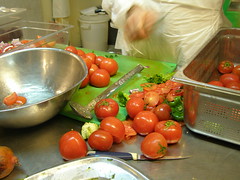
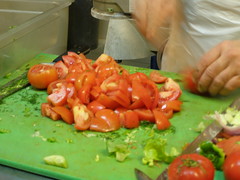
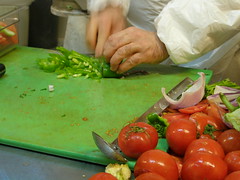
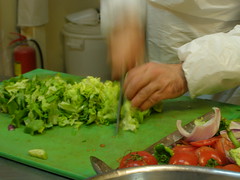
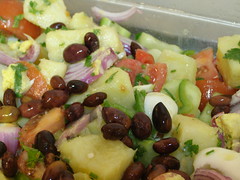


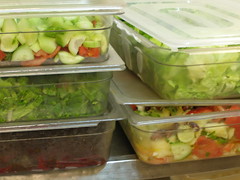

It is very interesting when local, traditional ingredients make their way into urban restaurant settings. And I like the Middle ages aroma of salad and, of course, the stuffed flowers, a fried food that can be crispy, light and fresh-tasting.
ReplyDeleteBtw, Choumeli is a bee-keeping product which is known all over Greece by various names(apomeli, melonero etc.)
Wonderful writing, great photos ... and a Mickle drooling at the food.
ReplyDeleteWhat an opportunity - getting to translate the work of an incredible chef.
What a colourful post! I think Greece is a place for poor people. The food is abundant, fruit and veg have reasonable prices, it is warm not so much heating needed and even the poor can go swimming in wonderful beaches. So the beach is another democratic place for the rich and the poor. I love the stuffed flowers. Don't they have a slight hint of indian food in taste?
ReplyDeleteWonderful that you are translating some local Cretan dishes for the rest of us. Local ingredients would be hard to find, but just like with other cuisines we are creative with substitutions.
ReplyDeleteWow, Maria. You have a big job. But, you live in food Heaven!
ReplyDeleteWhat an interesting post. I didn't know what choumeli was either, but I looked it up and it sounds like a very yummy honey derivative. I agree with you about online translation tools, they are very helpful with recipes. I sue it with French sites for example with great success.
ReplyDeleteMaria, I think it should be a fun experience to translate recipes. I agree that the best quality food always comes with the freshest ingredients. Have fun.
ReplyDeleteAbout translators, I tried to put translator in my blog, what after I saw how it translated my English writing to Turkish, I was laughing really hard! Of course, I took it out.
Great job you did Maria, with your excellent writing and the beautiful photos!
ReplyDelete